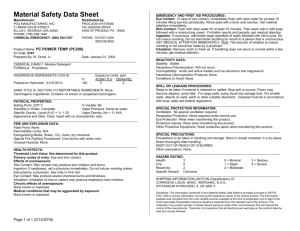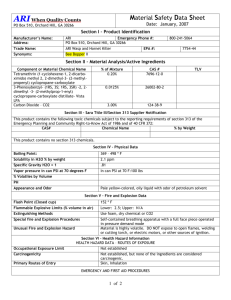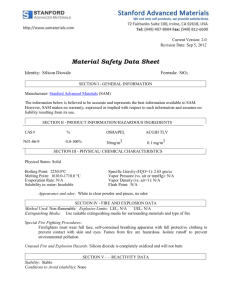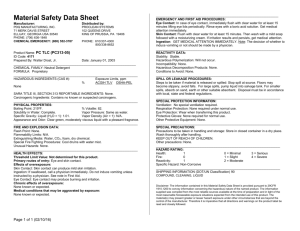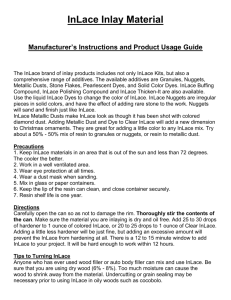Wet-Bond Underwater Epoxy: Hardener
advertisement
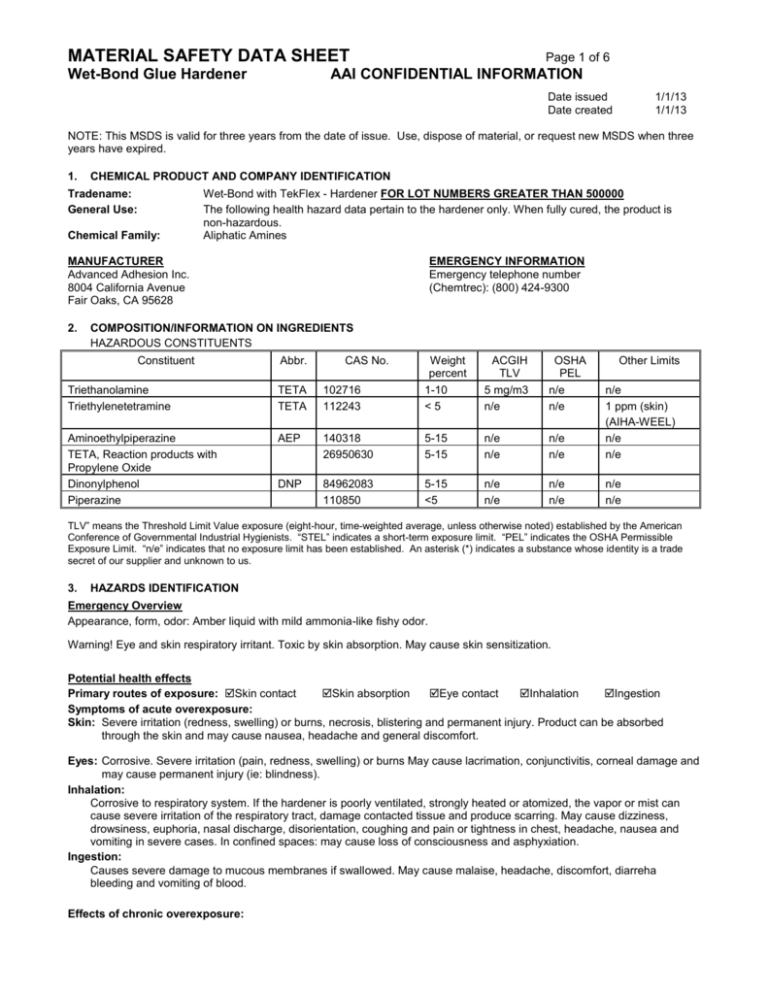
MATERIAL SAFETY DATA SHEET Wet-Bond Glue Hardener Page 1 of 6 AAI CONFIDENTIAL INFORMATION Date issued Date created 1/1/13 1/1/13 NOTE: This MSDS is valid for three years from the date of issue. Use, dispose of material, or request new MSDS when three years have expired. 1. CHEMICAL PRODUCT AND COMPANY IDENTIFICATION Tradename: General Use: Chemical Family: Wet-Bond with TekFlex - Hardener FOR LOT NUMBERS GREATER THAN 500000 The following health hazard data pertain to the hardener only. When fully cured, the product is non-hazardous. Aliphatic Amines MANUFACTURER Advanced Adhesion Inc. 8004 California Avenue Fair Oaks, CA 95628 2. EMERGENCY INFORMATION Emergency telephone number (Chemtrec): (800) 424-9300 COMPOSITION/INFORMATION ON INGREDIENTS HAZARDOUS CONSTITUENTS Constituent Abbr. CAS No. Triethanolamine Triethylenetetramine TETA TETA 102716 112243 Weight percent 1-10 <5 ACGIH TLV 5 mg/m3 n/e OSHA PEL n/e n/e Other Limits Aminoethylpiperazine TETA, Reaction products with Propylene Oxide Dinonylphenol Piperazine AEP 140318 26950630 5-15 5-15 n/e n/e n/e n/e n/e 1 ppm (skin) (AIHA-WEEL) n/e n/e DNP 84962083 110850 5-15 <5 n/e n/e n/e n/e n/e n/e TLV” means the Threshold Limit Value exposure (eight-hour, time-weighted average, unless otherwise noted) established by the American Conference of Governmental Industrial Hygienists. “STEL” indicates a short-term exposure limit. “PEL” indicates the OSHA Permissible Exposure Limit. “n/e” indicates that no exposure limit has been established. An asterisk (*) indicates a substance whose identity is a trade secret of our supplier and unknown to us. 3. HAZARDS IDENTIFICATION Emergency Overview Appearance, form, odor: Amber liquid with mild ammonia-like fishy odor. Warning! Eye and skin respiratory irritant. Toxic by skin absorption. May cause skin sensitization. Potential health effects Primary routes of exposure: Skin contact Skin absorption Eye contact Inhalation Ingestion Symptoms of acute overexposure: Skin: Severe irritation (redness, swelling) or burns, necrosis, blistering and permanent injury. Product can be absorbed through the skin and may cause nausea, headache and general discomfort. Eyes: Corrosive. Severe irritation (pain, redness, swelling) or burns May cause lacrimation, conjunctivitis, corneal damage and may cause permanent injury (ie: blindness). Inhalation: Corrosive to respiratory system. If the hardener is poorly ventilated, strongly heated or atomized, the vapor or mist can cause severe irritation of the respiratory tract, damage contacted tissue and produce scarring. May cause dizziness, drowsiness, euphoria, nasal discharge, disorientation, coughing and pain or tightness in chest, headache, nausea and vomiting in severe cases. In confined spaces: may cause loss of consciousness and asphyxiation. Ingestion: Causes severe damage to mucous membranes if swallowed. May cause malaise, headache, discomfort, diarreha bleeding and vomiting of blood. Effects of chronic overexposure: MATERIAL SAFETY DATA SHEET Wet-Bond Glue Hardener Page 2 of 6 AAI CONFIDENTIAL INFORMATION Prolonged or repeated overexposure by skin contact or inhalation may cause skin sensitization, with itching, swelling and rashes upon further exposure. Rearated or prolonged exposure may cause adverse respiratory effects (coughing, tightness of chest, shortness of breath), nervous system disorders (narcosis, behavioral changes, decreased motor function), muscular disfunction, eye effects (conjunctivitis, corneal damage), or skin effects (rash, irritation, corrosion). Carcinogenicity – OSHA regulated: No ACGIH: No National Toxicology Program: No International Agency for Research on Cancer: No Cancer-suspect constituent(s): None Medical conditions which may be aggravated by exposure: Eye disease, skin disorders and allergies, asthma and respiratory diseases (e.g. Bronchitis, Emphysema), Neurological disorders. Other effects: Repeated and/or prolonged exposure to low concentrations of vapor may cause: sore throat, eye irritation, which are transient. Corneal edema may give rise to a perception of “blue haze” or “fog around lights” which is transient and has no known residual effect. 4. FIRST AID MEASURES First aid for eyes: Immediately flush eye with clean water for at least 20 minutes while gently holding eyelids open, lifting upper and lower lids. Get immediate medical attention. First aid for skin: Immediately remove contaminated clothing and excess contaminant. Flush skin with water for at least 15 minutes. Wash thoroughly with soap and warm water. Consult a physician if irritation develops. First aid for inhalation: Remove patient to fresh air. Administer oxygen if breathing is difficult. Get medical attention if symptoms persist. First aid for ingestion: Do NOT induce vomiting. Administer 3-4 glasses of milk or water. Never give anything by mouth to an unconscious person. If vomiting occurs spontaneously, keep head below hips (if sitting) or to the side (if lying down) to prevent aspiration. Get immediate medical attention. Note to Physician: Highly injurious to all tissues, similar to that of ammonia or ammonia gas. Chemical pneumonitis, pulmonary edema, laryngeal edema and delayed scarring of the airway or other affected tissues may occur following exposure. Give supportive treatment similar to thermal burns. 5. FIRE FIGHTING MEASURES Extinguishing media: Water Carbon dioxide Dry chemical Foam Alcohol foam Flash Point (°F): >190 Method: estimate Explosive limits in air (percent) – Lower: n/d Upper: n/d Special firefighting procedures: Do not enter confined space without full bunker gear. Firefighters should wear self-contained breathing apparatus and protective clothing to prevent all skin and eye contact with this material. Cool fire exposed containers with water. Unusual fire and explosion hazards: Sudden reaction and fire may result if product is mixed with an oxidizing agent. Personnel in vicinity and downwind should be evacuated. Hazardous products of combustion: Acrid and toxic fumes with organic amines, ammonia, oxides of carbon and nitrogen. 6. ACCIDENTAL RELEASE MEASURES Spill control: Avoid personal contact. Evacuate area. Eliminate ignition sources. Ventilate area. Containment: Dike, contain and absorb with clay, sand or other suitable material. Cleanup: Using butyl rubber protective clothing and self-contained breathing apparatus, neutralize and reduce vapors with sodium bisulfate. Absorb spillage on inert material and discard in closed nonporous containers. MATERIAL SAFETY DATA SHEET Wet-Bond Glue Hardener Page 3 of 6 AAI CONFIDENTIAL INFORMATION Special procedures: Prevent spill from entering drainage/sewer systems, waterways, and surface waters. Collect run-off water and transfer to drums or tanks for later disposal. Notify local health authorities and other appropriate agencies if such contamination occurs. 7. HANDLING AND STORAGE Handling precautions: Avoid breathing vapors. Avoid contact with skin, eyes, or clothing. Wash thoroughly with soap and water after using and particularly before eating, drinking, smoking, applying cosmetics, or using toilet facilities. Launder contaminated clothing and protective gear before reuse. Discard contaminated leather articles. Handle mixed resin and hardener in accordance with the potential hazard of the curing agent used. Provide appropriate ventilation/respiratory protection against decomposition products (see Section 10) during welding/flame cutting operations and to protect against dust during sanding/grinding of cured product. Do NOT mix with sodium nitrite or other nitrosating agents as cancer-causing nitsrosamines could be formed. Storage: Store in a cool, dry area away from high temperatures and flames. Do NOT store in reactive metal containers. Keep away from acids, oxidizers. Keep container tightly closed when not in use. 8. EXPOSURE CONTROLS/PERSONAL PROTECTION Engineering controls Ventilation: Use ventilation that is adequate to keep employee exposure to airborne concentrations below exposure limits (or to the lowest feasible levels when limits have not been established). Although good general mechanical ventilation is usually adequate for most industrial applications, local exhaust ventilation is preferred (see ACGIH – Industrial Ventilation). Local exhaust may be required for confined areas (see OSHA 1910.146) Other engineering controls: Have emergency shower and eye wash stations available. Personal and protective equipment Eye and face protection: Full face shield with chemical goggles if liquid contact is likely, or safety glasses with side shields. Skin protection: Chemical-resistant rubber (e.g. neoprene, butyl rubber, nitrile) gloves and other gear as required to prevent skin contact. The breakthrough time of the selected glove(s) must be greater than the intended use period. Respiratory protection: None in normal use with proper ventilation. In poorly ventilated areas use NIOSH approved ammonia vapor cartridge respirator for uncured product , dust/particle respirator during grinding/sanding operations for cured product, or fresh airline respirator as exposure levels dictate. (See OSHA 1910.134) 9. PHYSICAL AND CHEMICAL PROPERTIES Specific gravity: Melting point (°F): Vapor pressure (mmHg): VOC (grams/liter): Percent volatile by volume: Percent solids by weight: n/d n/d <21mm Hg 0 0 100 at 70˚F Boiling point (°F): Vapor density (air = 1): Evaporation rate (butyl acetate = 1): Solubility in water PH (5% solution or slurry in water): >212 >1 <1 >30% alkaline MATERIAL SAFETY DATA SHEET Wet-Bond Glue Hardener Page 4 of 6 AAI CONFIDENTIAL INFORMATION 10. STABILITY AND REACTIVITY This material is chemically stable. Hazardous polymerization will not occur. Conditions to avoid: Extreme heat or open flame. Product slowly corrodes copper, aluminum, zinc and galvanized surfaces. Incompatible materials: Oxidizers, acids, Clorinated organic compounds. Reactive metals (e.f. Na, Ca, zinc). Sodium/calcium hypochlorite. Peroxides. Materials reactive with hydroxl compounds. Hazardous products of decomposition: Acrid, toxic smoke, organic & nitros amines; carbon & nitrogen oxides; nitriles; cyanic acid; isocyanates; cyanogens; amides; carbamates; nitric acid; ammonia; aldehydes; ketones. Conditions under which hazardous polymerization may occur: Heat is generated when resin is mixed with curing agents; Run-a-way cure reactions may char and decompose the resin, generating unidentified fumes and vapors which may be toxic. 11. TOXICOLOGICAL INFORMATION Acute oral effects: LD50 (rat): > 1600 mg/kg (estimate) Acute dermal effects: LD50 (rabbit): > 1000 mg/kg (estimate) Acute inhalation effects: LC50 (rat): Not determined. Exposure: 4 hours Eye irritation: Not available. Subchronic effects: TEA: prolonged and repeated ingestion has caused kidney damage in laboratory animals Carcinogenicity, teratogenicity, and mutagenicity: Results from a battery of short term genotoxicity tests on components in this material indicate mutagenic activity. TEA: male rats dermally exposed from 32-125 mg/kg showed a marginal increase in kidney tumors. Other chronic effects: No Data Available Toxicological information on hazardous chemical constituents of this product: Constituent Oral LD50 (rat) Dermal LD50 (rabbit) Inhalation LC50 4hr, (rat) Triethanolamine 8000 mg/kg >2000 mg/kg n/d Piperazine Aminoethylpiperazine 1900 mg/kg 2140 mg/kg 4 g/kg 880 mg/kg n/d n/d TETA, Reaction products with Propylene Oxide n/d >2000 mg/kg n/d Triethylenetetramine 2500 mg/kg 805 mg/kg n/d Dinonylphenol >10 g/kg >8 g/kg n/d “n/d” = “not determined” 12. ECOLOGICAL INFORMATION Ecotoxicity: Not available. Mobility and persistence: Not available. Environmental fate: Not available. 13. DISPOSAL CONSIDERATIONS Please see also Section 15, Regulatory Information. Waste management recommendations: If this hardener became a waste, it would not be a hazardous waste by RCRA criteria (40CFR 261). Dispose of according to applicable federal, state, and local regulations. Incinerate is the preferred method of disposal. MATERIAL SAFETY DATA SHEET Wet-Bond Glue Hardener Page 5 of 6 AAI CONFIDENTIAL INFORMATION 14. TRANSPORT INFORMATION Proper shipping name: Non-regulated Technical name: N/A Hazard class: N/A UN number: N/A Packing group: N/A Emergency Response Guide No.: N/A IMDG page number: N/A 15. REGULATORY INFORMATION U.S. Federal Regulations TSCA All ingredients of this product are listed, or are exempt from listing, on the TSCA inventory. The following RCRA code(s) applies to this material if it becomes waste: none Regulatory status of chemical constituents of this product: Constituent Extremely Hazardous* Toxic Chemical** CERCLA RQ (lbs) TSCA 12B Export Notification Triethylanolamine No No 0.0 Not Required Piperazine No No 0.0 Not required Triethylenetetramine No No 0.0 Not Required Aminoethylpiperazine No No 0.00 Not Required TETA, Reaction products with Propylene Oxide No No 0.00 Not Required Dinonylphenol No No 0.00 Not Required *Consult the appropriate regulations for emergency planning and release reporting requirements for substances on the SARA Section 301 Extremely Hazardous Substance list. **Substances for which the “Toxic Chemical” column is marked “Yes” are on the SARA Section 313 list of Toxic Chemicals, for which release reporting may be required. For specific requirements, consult the appropriate regulations. For purposes of SARA Section 312 hazardous materials inventory reporting, the following hazard classes apply to this material: - Immediate health hazard – Delayed health hazard – Fire hazard Canadian regulations WHMIS hazard class(es): E; B3; D2B All components of this product are on the Domestic Substances List. MATERIAL SAFETY DATA SHEET Wet-Bond Glue Hardener 16. Page 6 of 6 AAI CONFIDENTIAL INFORMATION OTHER INFORMATION Hazardous Materials Identification System (HMIS) Ratings: Health Flammability Reactivity 2* 2 1 The information and recommendations in this document are based on the best information available to us at the time of preparation, but we make no other warranty, express or implied, as to its correctness or completeness, or as to the results of reliance on this document.

